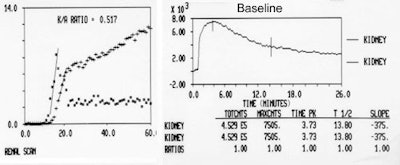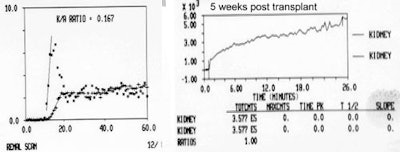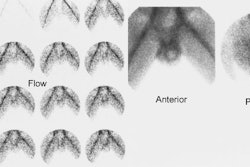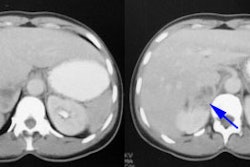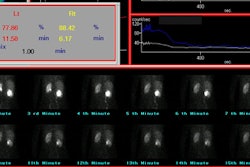Renal Transplant Evaluation
Pancreatic renal and pancreatic transplantRenal transplant has become the treatment of choice for end-stage
renal disease [1]. One year graft survival rates are reported to
be 80-89% for cadaveric renal grafts; 90% for non-identical living
related grafts; and 95% for human lymphocyte antigen-identical
grafts [1]. The 5-year graft survival rate is 66.5% for cadaveric
grafts and 80% for living donor grafts [11].
In heterotopic renal transplantation, the renal graft is implanted at a different site than the diseased organ (which is usually not removed from the patient) [8]. With few exceptions, the first transplant is placed extraperitoneally in the right iliac fossa because this location allows access to a wider choice of arteries and veins for reconstruction [8]. The renal vein is anastomosed to the external iliac vein, and the artery to the external iliac artery [8].
Historically, imaging was done using Tc-DTPA
and 131I Hippuran to
evaluate flow and function, but presently single agent- Tc-MAG3
imaging is performed because it is secreted by the renal tubules
and uptake occurs even in the setting of impaired glomerular
filtration [10].
When evaluating perfusion, the vascular blush of a normal functioning transplant should be almost simultaneous with that of external iliac artery and peak activity should equal that of the iliac artery. Extraction, excretion, and clearance of tracer activity should normally be similar to that of a native kidney. Delayed graft function affects 5-10% of transplant patients and can be secondary to acute tubular necrosis, acute rejection, and vascular or urologic complication [7]. Delayed function is associated with reduced GFR and higher blood pressure at one year, increased incidence of acute rejection, and reduced graft survival [7]. Presently, ultrasound is the method of choice for the first line evaluation of renal graft dysfunction [7].
Transplant
Rejection
Delayed graft function is defined as the need for dialysis in the
first week after renal transplant [13]. The greatest risk for
delayed graft function is cold ischemia time [13].
Clinically, transplant rejection is characterized by oliguria, weight gain, and constitutional symptoms such as fever and pain. Generally, urinary sodium is decreased (as opposed to ATN in which the urinary sodium is often increased). Physiologically, rejection is manifested by decreased perfusion at the small vessel level. There are 3 forms of rejection: Hyperacute, Acute, and Chronic.
1- Hyperacute Renal
Transplant Rejection:
Hyperactue rejection often begins within minutes to hours (usually by 24 hrs) of the transplant. It is due to the presence of pre-formed cytotoxic antibodies at time of transplant. It is an irreversible process. Pathologically there are thrombosed arterioles and cortical necrosis. Treatment is immediate reoperation.
2- Acute Renal Transplant Rejection:
Accelerated acute rejection refers to rejection which occurs between 1 to 5 days post transplant and is most commonly seen in patients who have received previous transplants, blood transfusions, or other causes of presensitization [13]. It is an antibody mediated process [13].
Acute rejection typically occurs 1 to 5 weeks following transplant (usually within 3 months). It is primarily a cell-mediated antigen-specific immune response, but antibodies are often found as well. Both accelerated acute and acute rejection are potentially reversible processes. Up to 50% of renal transplant patients experience at least one episode of acute rejection during their first year [1]. Patients typically present with malaise, fever, weight gain, or a painful kidney [1]. Patients receiving cyclosporine may be asymptomatic [1].
On scintigraphy, acute rejection is characterized by decreased renal perfusion and decreased tubular function which progressively worsens on serial evaluation. The nephrogram phase is prolonged and there will be delayed bladder visualization. Increased perinephric accumulation of Tc-DTPA signifies end-stage rejection as manifested by renal infarction.
|
Acute Rejection: Tc-MAG3 renal scan in a post-transplant patient. Flow and functional images, and renal curves are shown from a baseline post-op scan and a scan performed at 5 weeks post transplant. Baseline exam demonstrates prompt perfusion to the transplant. The 5 week post-op examination demonstrates markedly decreased renal perfusion to the transplanted kidney compared to baseline which is characteristic of acute rejection. The kidney to aorta flow ratio has decreased from 0.52 to 0.16 (See curves below). |
|
|
|
Acute Rejection: Tc-MAG3 renal scan functional images from the same case demonstrate essentially normal function on the baseline exam, but prolonged cortical retention and no evidence of excretion of the tracer on the 5 week examination. |
|
|
|
Acute Rejection: Tc-MAG3 renal scan curves from the same patient confirm visual findings of decreased perfusion and renal function in this patient with acute transplant rejection. |
|
|
On US, analysis of the intrarenal
arterial waveforms and measurement of the pulsatility
and resistive indexes can be used to evaluate graft function [9].
The normal PI is 1.36-1.56 and the normal RI is 0.6-0.8 [9]. The
sensitivity for the detection of acute rejection varies from
43-82%, and the specificity is between 33-100% [9]. Unfortunately,
the general consensus is that US cannot reliably distinguish acute
rejection from ATN [9]. However, elevated intrarenal RI (>0.74)
in the early post-operative period (between 1 week to 3 months)
has been shown to correlate with with diminished long-term
function of the graft at 1 year [13].
Tc-Sulfur Colloid has been shown to accumulate within transplanted kidneys that have undergone an episode of rejection. This occurs due to trapping of the labeled particles in small vessels occluded by fibrin thrombi. Transplant uptake will be more intense than that in surrounding bony structures. False-positive Tc-SC exams have been reported with infections and with high dose steroids [Seminars,Jan.95, p. 54-5]. In-111 platelets also accumulate in rejected renal transplants secondary to small vessel occlusion. A kidney-to-background ratio over 1.5 is associated with rejection. Labeled fibrinogen, gallium-67, and In-111 WBC's have also been used in the evaluation of transplant rejection with varying success.
3- Chronic Renal Transplant Rejection:
Chronic rejection can be seen 3 months to many years following transplantation. It is primarily mediated by a cellular immune response. Chronic rejection is a slow, insidious process characterized by gradual, progressive deterioration of allograft function over months to years. The kidney will be small and shrunken. Histologically, there is endothelial proliferation which leads to occlusion of small vessels, basal membrane thickening, and interstitial fibrosis. Although no therapy is available, chronic rejection may stabilize and borderline function can be maintained for years. Chronic rejection is the most common cause of late graft loss [1].
On scintigraphy, chronic rejection is characterized by decreased perfusion, a decreased accumulation of activity (maximum counts or peak activity), normal to slightly delayed time to peak activity (5 to 7 minutes), and a moderately increased cortical retention at 20 minutes (although parenchymal transit and cortical retention may be normal). Bladder activity may appear normally, or be slightly delayed (5 to 8 minutes) [2,3].
Doppler US has not proved to be as accurate for the evaluation of rejection as initially thought [1]. Ultrasound findings in rejection include decreased diastolic flow and an increased resistive index .
(Peak Systolic Vel.- End Diastolic Vel.)
RI = -----------------------------------------------
Peak Systolic Vel.
A RI greater than 0.8 is abnormal. A RI of 1.0 indicates absence of diastolic flow, while an RI greater than 1.0 indicates reversed flow during diastole.
The pulsatility index or PI (normal 1.36-1.56) = (Vmax ? Vmin)/ Vmean
OtherTransplant
Complications
ATN
Generally an early post-op complication (see below on ATN)
Hematoma
A small crescentic peritransplant fluid collection seen immediately after transplantation is most likely a hematoma or seroma [1]. They often appear complex on US and can have an echogenic appearance if acute [6]. Older hematomas appear anechoic (more closely resembling fluid), but they may contain septations [6].
Lymphocele
(15% incidence)
Lymphoceles are the most common peritransplant fluid collections, with a prevalence of 0.5-20% [6]. They are the result of leakage from surgically disrupted lymphatic channels along the iliac vessels [6]. Lymphoceles generally require some time (4 to 8 weeks) before they become large enough to produce symptoms. Lymphoceles usually occur medial to the transplant, between the graft and the urinary bladder [6]. Patients are usually asymptomatic, but can present secondary to symptoms of obstruction (lymphoceles are the most common fluid collection to cause hydronephrosis [6]). Patients also frequently develop lower extremity edema on the same side as the transplant. The differential considerations include a hematoma or a urinoma, but these usually present sooner. Small lymphoceles can be monitored serially for change, while larger ones should be drained [6]. Aspirated fluid should have a creatinine content equal to that of serum, and the cell count and differential may show relatively few white blood cells with a predominance of lymphocytes [6]. Lymphoceles commonly recur after simple percutaneous aspiration and may require prolonged catheter drainage or transcatheter sclerosis (with success rates up to 97%) [6].
Lymphoceles usually appear as a photodeficient region adjacent to the transplant on scintigraphy. On ultrasound they are anechoic and can have a multiseptated appearance [6]. On CT, a lymphocele is usually of water density [6].
Ureteral Obstruction
(1-10% incidence)
Urinary obstruction almost always occurs within the first 6 months following transplant [6]. Obstruction is most common at the site of implantation of the ureter into the urinary bladder [6]. Ureteral obstruction can occur due to stricture formation, a blood clot, edema at the anastamosis, or a lymphocele. More than 90% of ureteral stenoses occur in the distal third of the ureter [6]. Because the transplanted kidney is denervated, the patient may not complain of typical renal colic [6]. Symptoms include rising creatinine and decreased urine output. Treatment of post-transplant ureteral stricture can be performed with balloon dilatation with a success rate of about 90% (but with lower success in structures associated with chronic ishemia or periureteral fibrosis) [6].
Urine Extravasation/Urinoma
(Rare to 10% incidence)
Urine leak and urinoma are
relatively rare complications following transplant [6]. Symptoms
include urine leaking from the surgical wound, pain, fever,
decreased urine output, and an increased creatinine.
Urine leaks generally occur within the first few days to 2 weeks
post-op and the most common site is at the ureterovesical
anastamosis (related to surgical
technique). Urine leaks elsewhere in the collecting system usually
develop secondary to ischemia with resulting ureteral necrosis
[1]. Urine leaks can be associated with a high mortality. On US, a
urine leak or urinoma appears as a
well-defined, anechoic fluid collection that rapidly increases in
size [6]. Internal septations are
noted less commonly than in hematomas [1]. Drainage may be
performed and the higher creatinine
level of the fluid compared with its serum concentration
differentiates a urine leak from a seroma
or lymphocele [6]. Small urine leaks
may be treated with percutaneous nephrostomy and stent placement [6]. On
scintigraphy, a urinoma may be seen as a photopenic region
adjacent to the transplanted kidney that may (or may not) fill in
with tracer activity over time [10].
Perigraft hematoma:
Small incidental hematomas (< 50 mL) are generally clinically
insignificant, but large hematomas can be associated with
significant morbidity [12]. Early detection and surgical
evacuation of perigraft hematomas are critical in minimizing
further complications such as abscess formation, and reversing
renal dysfunction [12]. Because acute hematomas can appear
echogenic on US, up to 27% of clinically significant hematomas can
be missed or misclassified as small by US [12]. Peritransplant
hematoma volumes can be underestimated by approximately 50% by US
[12].
Vascular Complications
- Renal Artery Stenosis (1-10%): Renal artery stenosis is the most common vascular
complication of renal transplant [1]. It usually occurs in the
first year after transplantation [6]. Most commonly stenosis occurs at the anastomotic site and is short segment.
End-to-end anastomoses have a 3
fold greater risk of stenosis
compared to end-to-side anastomoses
[6]. It is also more common in cadaveric transplants than in
living donor transplants [11]. Patients present with new onset
hypertension, hypertension refractory to medical treatment,
and worsening renal function [11]. Captopril
scintigraphy is useful in these
cases [5]. Sonographic findings
which suggest stenosis include a
flow velocity of greater than 2 m/sec (suggestive of an
arterial stenosis of greater than 50%); a velocity gradient
between the stenotic and pre-stenotic segments of more than 2:1;
and marked spectral broadening (indicative of turbulence)
[1,11]. Other findings include the presence of tardus parvus
flow in a distal intergraft artery (tardus parvus refers to
spectral waveform broadening, a RI of less than 0.5, and a
systolic accelration time of more than 80 msec [the time
interval between end diastole and peak systolic velocity])
[11]. The RI is calculated by subtracting the end-diastolic
velocity from the peak systolic velocity and dividing by the
peak systolic velocity [11]. Note that Doppler US findings are
nonspecific in the first 72 hours following transplantation
[11]. Spurious flow velocity measurements may be
recorded in tortuous vessels or when the angle of insonation is
greater than 60? [11]. Stenosis
can be treated with percutaneous
angioplasty with initial improvement or cure in 73% of patients, however, repeat dilatation
may be required in up to 20% of cases for maximum success [6].
- Renal artery
occlusion: Renal artery occlusion is an uncommon complication
affecting less than 1% of renal transplant recipients [11].
Commonly associated with allografts
of disparate vessel size or multiple anastamoses.
The scintigraphic findings of a photon deficient transplant
compared to background indicates the organ is not
salvageable.
- Pseudoaneurysm: Usually the result of vascular trauma associated
with percutaneous biopsy.
- Renal vein
thrombosis: A rare cause (less than 5% of cases) of transplant
dysfunction which usually occurs within the first week after
transplantation [1,6,11]. However,
it is a major cause of early graft loss- accounting for
one-third of cases [11]. Patients develop sudden oliguria and graft tenderness [6].
There is an increased frequency of renal vein thrombosis in
left lower quadrant allografts
due to compression of the left common iliac vein between the
sacral promontory and the right common iliac artery [1,6,11].
Other
causes include hypovolemia,
venous compression by a peritransplant
fluid collection, dysfunctional anastomosis,
and slow flow secondary to rejection or other allograft
disease [6]. On US, the kidney may be enlarged and venous flow
is reduced or absent [6]. Arterial flow demonstrates increased
resistance and reversed diastolic flow [6]. MR venography can confirm the diagnosis
[6].
Stones:
Renal transplant patients are at an increased risk for developing urinary tract stones compared to the general population [6]. About 1-2% of patients develop a clinically significant stone [6].
Acute Tubular Necrosis (ATN)
Etiologies of ATN Include:
1- Early post-op renal transplant complication
Typically develops within 24 to 48 hours post-transplant and is rare after 1 month. Presently, transplant patients who require dialysis for the first week post-op due to ATN are said to have "delayed graft function." Delayed graft function affects 2-50% of transplant patients [9]. ATN is more frequent in cadaveric transplants due to ischemic damage prior to grafting and reperfusion injury than in transplanmts from living donors [1,10]. Cold ischemia times of more than 24 to 30 hours result in a higher frequency of ATN [1]. ATN is initially present in most cadaveric grafts. ATN resolves spontaneously over the first two weeks. ATN is infrequently seen in patients that receive grafts from living related donors [1].
Other causes of ATN include:
2- Hypotension/Ischemia; 3- Nephrotoxins; 4- Drug toxicity Aminoglycosides; 5- Ethelene glycol, Carbon tetrachloride; 6- IV contrast: Especially in patients with diabetic nephropathy; 7- Heavy metals: Mercury
Clinical Findings in ATN:
The primary symptom of ATN is oliguria. Transplant patients with ATN generally lack the constitutional symptoms which are seen in acute transplant rejection. Also, the renal dysfunction associated with ATN is generally temporary and will improve with time. On lab analysis the urinary sodium is generally elevated due to loss of concentrating ability by the kidney (tubular dysfunction).
Radiographic Findings
On IVP in non-transplant patients, the kidneys are smooth and enlarged. One can see an immediate, persistent, or increasingly dense nephrogram (75%), with little to no collecting system activity.
Scintigraphic Findings
On scintigraphy, perfusion is typically maintained or only slightly reduced, but GFR is very decreased. There is poor, but progressive/gradual accumulation and delayed excretion of renal tubular agents (due to tubular dysfunction).
In transplant patients the findings of severe ATN may be indistinguishable from acute transplant rejection with both decreased perfusion and reduced tracer uptake [10]. The time course and symptoms are key to the diagnosis [10]. On serial examination, renal transplant dysfunction secondary to ATN should improve or remain unchanged, while that due to rejection demonstrates progressive deterioration [10].
Differential Diagnosis of ATN in the Renal
Transplant Patient:
1- Cyclosporin
toxicity
(used to prevent rejection)
Cyclosporin produces a vasoconstrictive effect on the afferent glomerular arterioles [1]. A cyclosporin level greater than 300 ng/ml may suggest toxicity as the cause of poor allograft function. Although cyclosporin toxicity is not typically seen within the first month following transplant, nephrotoxicity can occur within 2 to 3 days of high dose cyclosporin administration. Severe cyclosporin toxicity classically produces findings similar to ATN on scintigraphy- with preserved perfusion, but poor tubular function. Renal perfusion may occasionally be impaired due to a reversible vasoconstriction of the afferent arterioles associated with the initial nephrotoxic effects of the agent. In this setting, the appearance will be similar to acute rejection. Resolution of cyclosporin toxicity with dose adjustment is usually rapid, permitting the retrospective diagnosis. In the later stages, there is irreversible injury to the renal microvasculature and interstitial fibrosis. The scintigraphic findings during this stage may be difficult to distinguish from chronic rejection. Although cyclosporin toxicity is usually a generalized process, focal areas of more prominent dysfunction may be seen. [2,4]
2- Acute rejection
A major point of distinction between rejection and ATN is that perfusion is compromised in rejection, but remains relatively normal in ATN.
3- Systemic hypotension
4- Obstruction
5- Acute renal failure
Drug induced, Urate nephropathy, Renal vein thrombosis
REFERENCES:
(1) Radiographics 2000; Brown ED, et al. Complications of renal transplantation: Evaluation with US and radionuclide imaging. 20: 607-622.
(2) Nuclear Medicine Annual 92, p.195
(3) Semin Nucl Med 1995; Dubovsky EV, et al. Radionuclide evaluation of renal transplants. 25(1):49-59. Review.
(4) Critical Reviews in Diagnostic Imaging 1991; Taylor A. Radionuclide evaluation of renal function. 32(1):1-36
(5) Nuc Med Communications 1993; 14(11): 969-75
(6) Radiographics 2005; Akbar SA, et al. Complications of renal transplantation. 25: 1335-1356
(7) J Nucl Med 2006; Boubaker A, et al. Radionuclide investigations of the urinary tract in the era of multimodality imaging. 47: 1819-1836
(8) Radiographics 2010; Catala V, et al. Use of multidetector CT in presurgical evaluation of potential kidney trasnsplant recipients. 30: 517-531
(9) Radiology 2011; McArthur C, et al. Early measurement of pulsatility and resistive indexes:
correlation with long-term renal transplant function. 239: 278-285
(10) Radiographics 2013; Uliel L, et al. Nuclear medicine in the
acute clinical setting: indications, imaging findings, and
potential pitfalls. 33: 375-396
(11) Radiographics 2013; Low G, et al. Imaging of vascular
complications and their consequences following transplantation in
the abdomen. 33: 633-652
(12) AJR 2015; Fananapazir G, et al. Sonographic evaluation of
clinically significant perigraft hematomas in kidney transplant
recipients. 205: 802-806
(13) Radiographics 2019; Sugi MD, et al. Imaging of renal transplant complications throughout life of the allograft: comprehensive multimodality review. 39: 1327-1355




